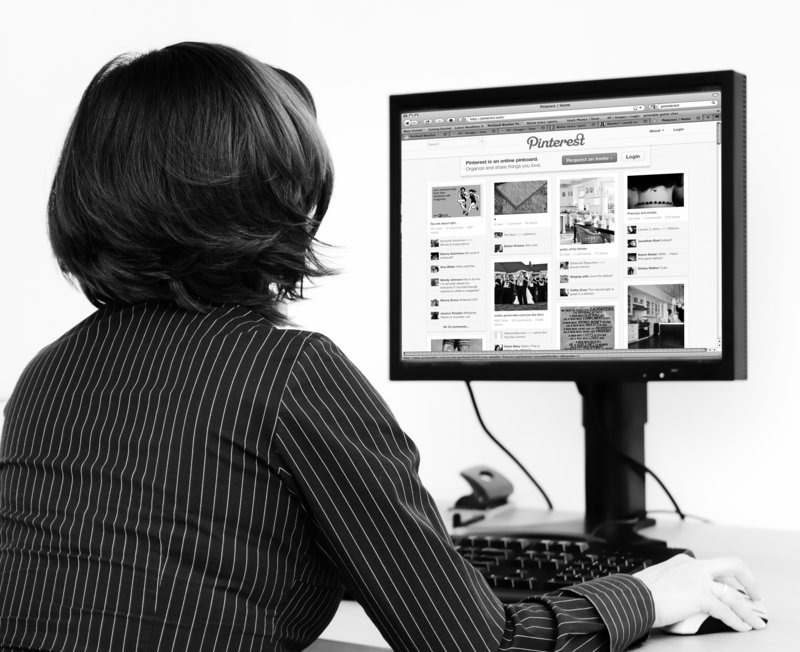LOS ANGELES – To orchestrate her wedding next month, Dara Weiner’s biggest helper isn’t her party planner or her devoted fiance – it’s the Pinterest website that now dominates the time she spends online.
Weiner browses the site checking out thousands of photos collected by users and “pinned up” on their online scrapbooks. When she likes an image of a table setting, a dress or a bouquet, Weiner will earmark the photo by “pinning” it on her own Pinterest page to keep for inspiration.
“I’ve planned 70 percent of my wedding around pictures I’ve seen on Pinterest,” said Weiner, 40, of Newport Beach, Calif. “Even beyond the wedding, I look at it to get ideas for clothes, for food, for whatever.”
Like Instagram, the photo-sharing application that was just snapped up by Facebook Inc. for $1 billion, Pinterest reflects the ravenous appetite for images on the Web. The site drew 23.7 million unique visitors in February, up from 3.5 million in September, according to research firm Nielsen. Another firm, Experian Marketing Services, ranks Pinterest as the third-most-popular social networking site, behind Facebook and Twitter.
That kind of growth has caught the attention of corporate America, which is looking to exploit its potential to sell goods and services.
“It’s being viewed as the hot new thing in social networking,” said Colin Gibbs, an analyst at research firm GigaOM Pro.
Pinterest, whose name combines “pin” and “interest,” allows members to share images of products they like and create digital versions of homemade scrapbooks. There isn’t much room for commentary, which analysts say can give it more appeal to advertisers than sites like Facebook and Twitter, which can be platforms for consumer discontent as much as commerce.
About 70 percent of Pinterest’s users are women, who use the site to post images of their favorite fashions, housewares and food.
“Facebook is like being at a cocktail party, whereas Pinterest is almost like a Tupperware party,” said Scot Wingo, chief executive of ChannelAdvisor, which advises companies on e-commerce. “People are not just chatting about anything – sports talk, or ‘oh my God, my mom is sick,’ or ‘I love my cat’ – it’s already more commercial. It’s people saying, ‘I love this product.’ “
Neiman Marcus Inc. recently unveiled Pinterest pages for its retail stores. Ann Taylor is hosting a “Pin It” contest for the launch of its bridal collection. Home improvement chain Lowe’s Cos. incorporated a Pinterest tab to its Facebook account last month.
Even the National Association of Realtors is urging real estate agents to use Pinterest to show off homes for sale.
Etsy, the online marketplace for craft and vintage goods, has found that traffic coming from Pinterest jumped 30 percent since January. The company recently added “Pin It” buttons to its own website so shoppers can easily add photos to their own Pinterest accounts directly from Etsy, and it enabled a feature so any photos that are pinned – say, of vintage watch – can include a price in the corner.
“It’s extended window-shopping for users,” said Sean Flannagan, senior product manager at Etsy, who declined to say how much Pinterest traffic turns in to actual sales. “When it comes to buying and shopping, if you can stash and collect items and create a pin board, it lets you sort through all the options and come back later to decide.”
Despite Pinterest’s somewhat homespun appeal, its root are high tech. Based in Palo Alto, Calif., its founders hail from Facebook and Google Inc., and they have been bankrolled by $37.5 million in venture capital funding.
Ben Silbermann co-founded the site in 2009 after a stint designing display ads at Google. He said he wanted Pinterest to “be familiar to people, like tearing pages out of a magazine.”
“When I go to someone’s house, I like to check out their bookshelf, or how they decorate their homes, what they choose to hang on the wall,” Silbermann said in an interview last year. “I always felt like that said a lot about who you are as a person.”
The company, which now has about 30 employees, has been criticized for not disclosing its use of affiliate marketing, which allows merchants to post links to their own stores in exchange for a cut of any resulting sales. Pinterest officials declined to address these complaints or to discuss the commercial aspects of the social-networking site.
Shoppers can’t buy anything directly off Pinterest and are usually redirected to a retailer’s own e-commerce site.
But it’s useful as a digital catalog, and a recent survey reported that 21 percent of Pinterest users have purchased products after seeing them on the site. Users spend about 1 hour a month on the site, compared with 21 minutes on Twitter and 17 minutes on LinkedIn, according to research firm ComScore Inc.
Industry watchers say that Pinterest could eventually go public or be purchased by a larger tech company.
The company is believed to be valued at about $400 million and could fetch $2 billion if it’s sold, said Sam Hamadeh, chief executive of financial data firm PrivCo.
Send questions/comments to the editors.



Success. Please wait for the page to reload. If the page does not reload within 5 seconds, please refresh the page.
Enter your email and password to access comments.
Hi, to comment on stories you must . This profile is in addition to your subscription and website login.
Already have a commenting profile? .
Invalid username/password.
Please check your email to confirm and complete your registration.
Only subscribers are eligible to post comments. Please subscribe or login first for digital access. Here’s why.
Use the form below to reset your password. When you've submitted your account email, we will send an email with a reset code.